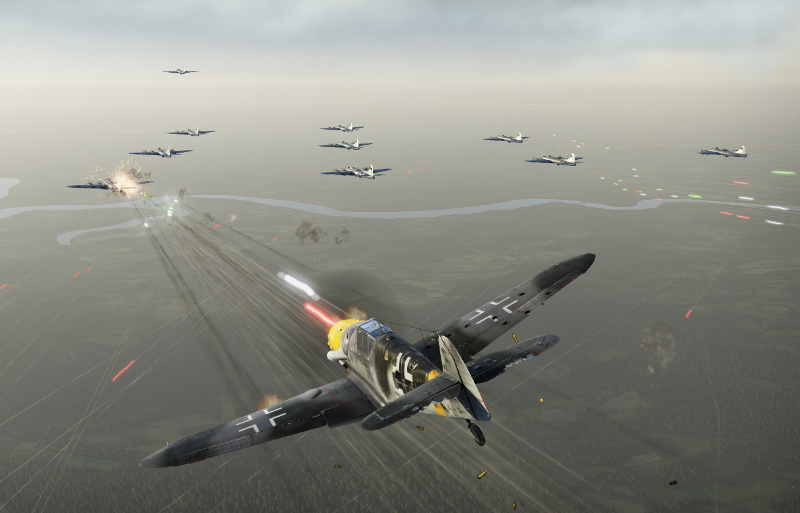
- Für PC
- Für MAC
- Für Linux
- Betriebssystem: Windows 10 (64bit)
- Prozessor: Dual-Core 2.2 GHz
- Arbeitsspeicher: 4GB
- DirectX 11 fähige Grafikkarte: AMD Radeon 77XX / NVIDIA GeForce GTX 660; die geringste Auflösung für das Spiel beträgt 720p
- Netzwerk: Breitband-Internetverbindung
- Festplatte: 21,5 GB (minimaler Client)
- Betriebssystem: Windows 10/11 (64bit)
- Prozessor: Intel Core i5 / Ryzen 5 3600 oder besser
- Arbeitsspeicher: 16 GB und mehr
- DirectX 11 fähige Grafikkarte oder höher mit den neuesten Treibern: NVIDIA GeForce GTX 1060 oder höher / AMD Radeon RX 570 oder höher
- Netzwerk: Breitband-Internetverbindung
- Festplatte: 60,2 GB (Full Client)
- Betriebssystem: Mac OS Big Sur 11.0 oder neuer
- Prozessor: Intel Core i5, 2.2 GHz (Intel Xeon Prozessoren werden nicht unterstützt)
- Arbeitsspeicher: 6 GB
- Grafikkarte: Intel Iris Pro 5200 oder analoge AMD / Nvidia für Mac. Die geringste Auflösung des Spiels beträgt 720p mit Metal Support
- Netzwerk: Breitband-Internetverbindung
- Festplatte: 21,5 GB (minimaler Client)
- Betriebssystem: Mac OS Big Sur 11.0 oder neuer
- Prozessor: Intel Core i7 (Intel Xeon Prozessoren werden nicht unterstützt)
- Arbeitsspeicher: 8 GB
- Grafikkarte: Radeon Vega II oder höher mit Metal Support
- Netzwerk: Breitband-Internetverbindung
- Festplatte: 60,2 GB (Full Client)
- Betriebssystem: neueste 64bit Linux Systeme
- Prozessor: Dual-Core 2.4 GHz
- Arbeitsspeicher: 4 GB
- Grafikkarte: NVIDIA 660 mit den neuesten Treibern (nicht älter als 6 Monate) / vergleichbare AMD mit den neuesten Treibern (nicht älter als 6 Monate); die geringste Auflösung für das Spiel beträgt 720p mit Vulkan Support
- Netzwerk: Breitband-Internetverbindung
- Festplatte: 21,5 GB (minimaler Client)
- Betriebssystem: Ubuntu 20.04 64bit
- Prozessor: Intel Core i7
- Arbeitsspeicher: 16 GB
- Grafikkarte: NVIDIA 1060 mit den neuesten Treibern (nicht älter als 6 Monate) / vergleichbare AMD (Radeon RX 570) mit den neuesten Treibern (nicht älter als 6 Monate); mit Vulkan Support
- Netzwerk: Breitband-Internetverbindung
- Festplatte: 60,2 GB (Full Client)
Spezialrabatt bis zum 11. Januar um 09:00 Uhr deutscher Zeit:
30% Rabatt beim Kauf beliebiger Bf 109
.jpg)
Günther Rall nach seinem 250. Abschuss
Bundesarchiv, Bild 183-J16509 / CC-BY-SA
Wird noch übersetzt! Wir bitten um euer Verständnis!
Born on March 10th 1918 in Gaggenau in the Black Forest, Gunther Rall’s father was a veteran of the First World War who worked in administration after the war. The Rall family moved to Stuttgart when Gunther was three years old; his education culminated with nine years at Karls-Gymnasium, where he later recalled the emphasis of his lessons being more on classical studies rather than the sciences. After passing his university entrance exams and completing a year of compulsory labour service, Rall entered the Wermacht as an officer cadet in the infantry.
However, in 1938 Rall transferred to the Luftwaffe after meeting an old friend and hearing his stories about flying. After graduation as a Leutnant and following a strong performance during pilot training, he was selected to fly single seat fighters and trained in his role east of Berlin before joining his first unit -Jagdgeschwader 52. It was not until May 1940 that he first saw combat in the skies over France; he shot down his first aircraft – a French Curtis Hawk flown by a Czech pilot on May 18th; some other sources credit this as his second kill, having possibly shot down a Hawk six days earlier. After France surrendered Rall moved with JG52 to Calais. During the Battle of Britain JG52 spent much of its time escorting bombers, particular the slow and vulnerable Ju87 Stuka. JG52 suffered horrific casualties against the British, with the Group Commander, adjutant and three squadron commanders being lost in only a few weeks, mainly to the Spitfires of the RAF’s No.610 Squadron. Rall was quickly promoted to lead one of the group’s squadrons as staffelkapitan and was also promoted in rank to Oberleutnant, but the experiences of the Battle of Britain had a lasting effect with him. Although involved in the thick of the action, Rall did not confirm a single kill against the British. After fighting against many nations across several theatres, Rall would later go on record to say that the British fighter pilot was the most aggressive and capable pilot of the entire war. Following defeat in the Battle of Britain, JG52 moved to Romania to defend the nation’s strategically vital oil refineries. The group moved to Crete to support the airborne landings before returning to Romania for Operation Barbarossa.
The bulk of Rall’s career was spent fighting against the Soviet Union on the Eastern Front; he participated in Operation Barbarossa in June 1941 and remained in this theatre until 1944. His first encounter with Soviet forces occurred whilst his squadron was operating out of Constanza in Romania, where he intercepted a group of unescorted DB-3 bombers and shot down several. His squadron accounted for some 50 Soviet bombers over the next few days. On a sortie on November 1941, Rall claimed his 36th victory – a Soviet fighter – but in the near darkness was then himself shot down between Taganrog and Rostov. Nursing his crippled Bf109 back over friendly lines, he crash landed in a gully but his unconscious body was recovered by German tank crews. Upon reaching hospital in Vienna, he was told that he had broken his back in three places and would never walk again. However, showing the will and determination he would become legendary for, he defied medical advice and not only walked again but returned to flying duties in August 1942. This was the first of four significant injuries; it was during treatment at a hospital in Vienna that he met Doctor Hertha Schon who would later become his wife. This brought Rall to the attention of the Gestapo, as his wife had assisted Jews leaving Vienna in 1938.
On September 3rd Rall was decorated with the Knight’s Cross of the Iron Cross after shooting down his 65th enemy aircraft. Oak Leaves were added to his Knight’s Cross the following month after he scored his 100th kill, personally presented to him by Adolf Hitler. Rall was personally decorated by Hitler on four occasions; he later recalled that his first meeting with the Fuhrer in 1942 destroyed many of his illusions about Nazi Germany. Rall was given command of III/JG52 – the third fighter wing of the group - in April 1943 and promoted to Hauptmann. On April 20th Rall shot down JG52’s 5000th kill. Nine days later he claimed his 200th victory whilst flying his 555th operational sortie. He again met Hitler and was presented with Swords to add to his Knight’s Cross with Oak Leaves. In October 1943 alone, Rall claimed 40 enemy aircraft shot down. Constantly involved in front line operations Rall himself was shot down seven times by Soviet pilots. In November, Rall was promoted to Major; with now over 250 kills to his credit, Rall ranked amongst the most successful fighter pilots of the entire Luftwaffe. Like First World War ace Manfred von Richthofen, Rall was remembered by many of his comrades for his gunnery over his piloting; he had a talent for scoring hits from extreme ranges and during difficult crossing angles, although he preferred to close to much shorter ranges when the opportunity presented itself.
 In April 1944 he returned to Germany to fly in defence of the Reich against the American day bombing of the US 8th Air Force. He was nowkommandeur of II.JG11, equipped with a mixture of the Bf109G-6 and FW190. Rall himself continued to favour the Bf109. His first victory was a P-38 to the north of Hannover at 26,000 feet. On May 12th 1944 Rall led an attack against a large formation of USAAF B-17 bombers near Nassau when nearly 900 American aircraft were sent to attack six major oil refineries. Rall dived down to become locked in combat with their escorting P-47 Thunderbolts and in the ensuing combat shot down one or two of the P-47s, again depending on the source quoted. He was then himself shot down along with the other three Messerschmitts of his schwarm by the American fighters; he managed to parachute to safety but a fifty caliber bullet had taken off his left thumb and the he spent the next six months in hospital due to infection. After being discharged from hospital Rall was employed as an instructor – a job he was later vocally thankful for due to the horrific rate of casualties suffered by German pilots during defence of the Reich. He also had the opportunity to fly several captured enemy aircraft but was most impressed by the P-51 Mustang; whilst he admitted to fearing the British pilot the most, he would later say that it was the American P-51 which he considered to be the greatest threat in terms of enemy aircraft, although this was in his opinion closely followed by the Spitfire and the La-7. Rall did, however return to front line duties and took command of JG300 in early 1945. On arriving to take command of his new unit he was forced to dive into a ditch as American fighters strafed the airfield, leaving fifteen Bf109s ablaze. Sensing the end of the war was near, he told his men that their first priority was to stay alive rather than blindly follow orders resulting in their deaths. After the cessation of hostilities he was captured by US forces and interrogated by both the Americans in Germany and the British at RAF Tangmere.
In April 1944 he returned to Germany to fly in defence of the Reich against the American day bombing of the US 8th Air Force. He was nowkommandeur of II.JG11, equipped with a mixture of the Bf109G-6 and FW190. Rall himself continued to favour the Bf109. His first victory was a P-38 to the north of Hannover at 26,000 feet. On May 12th 1944 Rall led an attack against a large formation of USAAF B-17 bombers near Nassau when nearly 900 American aircraft were sent to attack six major oil refineries. Rall dived down to become locked in combat with their escorting P-47 Thunderbolts and in the ensuing combat shot down one or two of the P-47s, again depending on the source quoted. He was then himself shot down along with the other three Messerschmitts of his schwarm by the American fighters; he managed to parachute to safety but a fifty caliber bullet had taken off his left thumb and the he spent the next six months in hospital due to infection. After being discharged from hospital Rall was employed as an instructor – a job he was later vocally thankful for due to the horrific rate of casualties suffered by German pilots during defence of the Reich. He also had the opportunity to fly several captured enemy aircraft but was most impressed by the P-51 Mustang; whilst he admitted to fearing the British pilot the most, he would later say that it was the American P-51 which he considered to be the greatest threat in terms of enemy aircraft, although this was in his opinion closely followed by the Spitfire and the La-7. Rall did, however return to front line duties and took command of JG300 in early 1945. On arriving to take command of his new unit he was forced to dive into a ditch as American fighters strafed the airfield, leaving fifteen Bf109s ablaze. Sensing the end of the war was near, he told his men that their first priority was to stay alive rather than blindly follow orders resulting in their deaths. After the cessation of hostilities he was captured by US forces and interrogated by both the Americans in Germany and the British at RAF Tangmere.
After the war he started a small woodcutting business whilst he wife continued to pursue her medical career; he also became a teacher and school administrator as well as working for Siemens. In July 1955 the West German parliament made the decision to set up the Bundeswehr; West Germany’s new armed forces, and after contact from some of his old friends Rall was persuaded to volunteer. He later said that he considered this to be a wonderful opportunity to restore Germany’s military to honour after years of ‘betrayal’ and ‘cheating’ from Hitler and his regime. Given his former rank of Major, Rall re-joined the Luftwaffe and trained in Germany and then the United States on the Republic F-84 Thunderjet. He also helped to introduce the Lockheed F-104 Starfighter as the new Luftwaffe’s main fighter. By 1971, Rall had risen through the ranks to command the West German Air Force until his move to Brussels in 1974 as German representative to NATO. A year later he was suddenly dismissed by Defense Minister Georg Leber under suspicious circumstances following what is now thought to have been an officially sanctioned visit to South Africa.
Rall spent much of his retirement travelling abroad and touring the historic aviation circuit; a popular regular at aviation events internationally and as a lecturer. After a phenomenally successful career as a front line pilot and military leader, Gunther Rall passed away in October 2009 following a heart attack. He is officially credited with 275 aerial victories in 621 operational sorties; most sources seem to agree that 272 of these were Soviet aircraft, but disagree on the number of kills in May 1940 and against the P-47s on the day he lost his thumb. Either way, on numbers alone this makes him the third highest scoring fighter ace in history. He was fondly remembered by friends and colleagues – many of whom were former adversaries – as a humble, approachable and gregarious man. Rall is perhaps best remembered as a man who looked to the future rather than dwelling in the past; the only visible link to the Second World War he maintained was a plaque on the wall of his home given to him by Lockheed test pilot Lute Eldridge. The plaque was etched with the poem ‘High Flight’ by American Spitfire pilot John Gillespie Magee Jr.
The author
 Mark Barber, War Thunder Historical Consultant
Mark Barber, War Thunder Historical Consultant
Mark Barber ist Pilot der Royal Navy's Fleet Air Arm. Sein erstes Buch wurde im November 2008 von Osprey Publishing veröffentlicht. Er schrieb noch weitere Titel für Osprey un veröffentlichte weitere Titel für verschiedene Magazine. Darunter gehört auch das meistverkaufte Luftfahrtmagazin Großbrittaniens "Flypast". Sein größtes Interesse gilt der britischen Marinefliegerei im 1. und 2. Weltkrieg und dem RAF Fighter Command im 2. Weltkrieg. Er ist für Gaijin als historischer Berater tätig, hilft im Historischen Bereich des War Thunder Forums und schreibt die "Ass des Monats" Serie.



